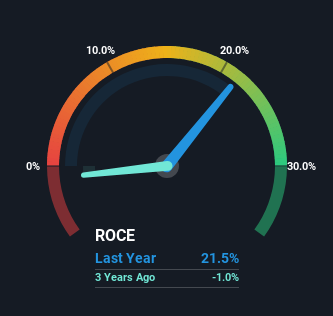- India
- /
- General Merchandise and Department Stores
- /
- NSEI:RTNINDIA
Why The 21% Return On Capital At RattanIndia Enterprises (NSE:RTNINDIA) Should Have Your Attention

If we want to find a potential multi-bagger, often there are underlying trends that can provide clues. Firstly, we'll want to see a proven return on capital employed (ROCE) that is increasing, and secondly, an expanding base of capital employed. Ultimately, this demonstrates that it's a business that is reinvesting profits at increasing rates of return. And in light of that, the trends we're seeing at RattanIndia Enterprises' (NSE:RTNINDIA) look very promising so lets take a look.
Understanding Return On Capital Employed (ROCE)
If you haven't worked with ROCE before, it measures the 'return' (pre-tax profit) a company generates from capital employed in its business. The formula for this calculation on RattanIndia Enterprises is:
Return on Capital Employed = Earnings Before Interest and Tax (EBIT) ÷ (Total Assets - Current Liabilities)
0.21 = ₹1.7b ÷ (₹30b - ₹23b) (Based on the trailing twelve months to December 2023).
So, RattanIndia Enterprises has an ROCE of 21%. In absolute terms that's a great return and it's even better than the Multiline Retail industry average of 5.7%.
Check out our latest analysis for RattanIndia Enterprises

Above you can see how the current ROCE for RattanIndia Enterprises compares to its prior returns on capital, but there's only so much you can tell from the past. If you'd like to see what analysts are forecasting going forward, you should check out our free report for RattanIndia Enterprises.
How Are Returns Trending?
RattanIndia Enterprises has broken into the black (profitability) and we're sure it's a sight for sore eyes. While the business was unprofitable in the past, it's now turned things around and is earning 21% on its capital. Interestingly, the capital employed by the business has remained relatively flat, so these higher returns are either from prior investments paying off or increased efficiencies. So while we're happy that the business is more efficient, just keep in mind that could mean that going forward the business is lacking areas to invest internally for growth. So if you're looking for high growth, you'll want to see a business's capital employed also increasing.
For the record though, there was a noticeable increase in the company's current liabilities over the period, so we would attribute some of the ROCE growth to that. Effectively this means that suppliers or short-term creditors are now funding 74% of the business, which is more than it was five years ago. Given it's pretty high ratio, we'd remind investors that having current liabilities at those levels can bring about some risks in certain businesses.
What We Can Learn From RattanIndia Enterprises' ROCE
In summary, we're delighted to see that RattanIndia Enterprises has been able to increase efficiencies and earn higher rates of return on the same amount of capital. And with the stock having performed exceptionally well over the last five years, these patterns are being accounted for by investors. In light of that, we think it's worth looking further into this stock because if RattanIndia Enterprises can keep these trends up, it could have a bright future ahead.
Since virtually every company faces some risks, it's worth knowing what they are, and we've spotted 4 warning signs for RattanIndia Enterprises (of which 1 is potentially serious!) that you should know about.
If you'd like to see other companies earning high returns, check out our free list of companies earning high returns with solid balance sheets here.
New: AI Stock Screener & Alerts
Our new AI Stock Screener scans the market every day to uncover opportunities.
• Dividend Powerhouses (3%+ Yield)
• Undervalued Small Caps with Insider Buying
• High growth Tech and AI Companies
Or build your own from over 50 metrics.
Have feedback on this article? Concerned about the content? Get in touch with us directly. Alternatively, email editorial-team (at) simplywallst.com.
This article by Simply Wall St is general in nature. We provide commentary based on historical data and analyst forecasts only using an unbiased methodology and our articles are not intended to be financial advice. It does not constitute a recommendation to buy or sell any stock, and does not take account of your objectives, or your financial situation. We aim to bring you long-term focused analysis driven by fundamental data. Note that our analysis may not factor in the latest price-sensitive company announcements or qualitative material. Simply Wall St has no position in any stocks mentioned.
About NSEI:RTNINDIA
RattanIndia Enterprises
Engages in the manpower, human resource supply and consultancy, payroll management, technology, and other related services in India.
Slightly overvalued with questionable track record.
Market Insights
Community Narratives




